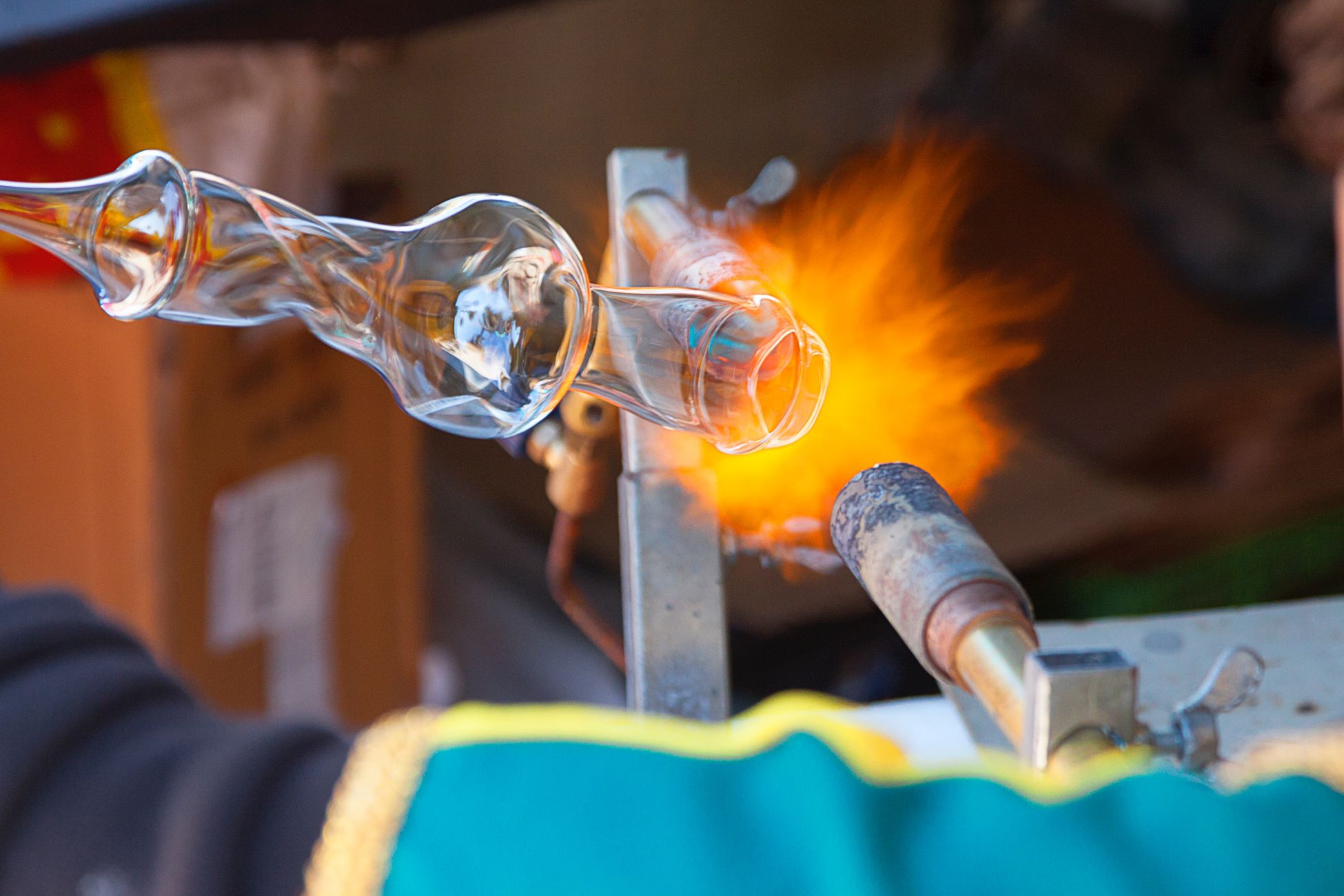Home>Furniture & Design>Interior Design Trends>What Is A Glass Blower


Interior Design Trends
What Is A Glass Blower
Modified: August 28, 2024
Discover the art of glass blowing and its impact on interior design trends. Learn about the techniques and styles that are shaping modern decor.
(Many of the links in this article redirect to a specific reviewed product. Your purchase of these products through affiliate links helps to generate commission for Storables.com, at no extra cost. Learn more)
Introduction
Glass blowing is an ancient art form that has captivated people for centuries. It is a mesmerizing craft that involves shaping molten glass into intricate and delicate forms, creating stunning works of art and functional objects. The process of glass blowing requires skill, precision, and creativity, making it a truly remarkable and awe-inspiring practice.
The art of glass blowing dates back to the 1st century BCE, with its origins rooted in the Roman Empire. Over time, it has evolved into a highly refined and respected art form, with artisans continually pushing the boundaries of what is possible with this versatile material. From delicate ornaments to intricate sculptures, glass blowing has found its way into countless aspects of our lives, adding beauty and elegance to the world around us.
As we delve into the world of glass blowing, we will explore its rich history, the tools and equipment used in the process, the techniques employed by skilled artisans, the various types of glass blowing, and the wide-ranging applications of this art form. Additionally, we will highlight some of the most renowned glass blowers who have left an indelible mark on this captivating craft.
Join us on a journey through the mesmerizing world of glass blowing, where creativity knows no bounds and molten glass is transformed into breathtaking works of art.
Key Takeaways:
- Glass blowing is an ancient art form that involves shaping molten glass into stunning works of art and functional objects. It requires skill, precision, and creativity, showcasing the enduring allure of this mesmerizing craft.
- The art of glass blowing encompasses diverse techniques, from free-blown and mold-blown glass to lampworking and hot sculpting. It finds applications in functional glassware, artistic sculptures, decorative ornaments, architectural installations, and scientific glassware, showcasing its versatility and impact across various industries and creative endeavors.
Read more: What Is A Leaf Blower
History of Glass Blowing
The history of glass blowing is a tale as old as time, with its origins tracing back to the 1st century BCE in the Roman Empire. This ancient art form revolutionized the way glass was manipulated, allowing artisans to create intricate and delicate objects that were previously unattainable. The invention of glass blowing marked a significant advancement in the world of craftsmanship, paving the way for the creation of a wide array of glassware and decorative pieces.
The technique of glass blowing is believed to have been discovered accidentally by Syrian craftsmen who were working with molten glass around 50 BCE. This serendipitous discovery led to the development of glass blowing as a distinct art form, with the Roman Empire quickly embracing and refining the practice. The ability to shape molten glass into various forms revolutionized the production of glass vessels, leading to an increase in their availability and affordability.
During the medieval period, the art of glass blowing spread across Europe, with Venice emerging as a prominent hub for glass production. Skilled artisans in Venice honed their craft, perfecting the techniques of glass blowing and elevating it to new heights. The Venetian glassblowers became renowned for their exquisite glasswork, setting the stage for the city to become synonymous with exceptional glass artistry.
As the centuries passed, the art of glass blowing continued to evolve, with innovations in techniques and the introduction of new tools and equipment. The industrial revolution further transformed the glass blowing industry, leading to mass production and the widespread availability of glass products.
Today, the legacy of glass blowing lives on, with contemporary artisans pushing the boundaries of the craft and exploring new possibilities. The rich history of glass blowing serves as a testament to the enduring allure of this ancient art form, showcasing the timeless beauty and versatility of glass as a medium for artistic expression.
Tools and Equipment
The art of glass blowing requires a specialized set of tools and equipment that are essential for shaping and manipulating molten glass into exquisite creations. These tools have been refined over centuries, each serving a unique purpose in the intricate process of glass blowing.
Blowpipe
The blowpipe, also known as a blow tube, is a fundamental tool used in glass blowing. It is a long metal tube, typically made of stainless steel, with a mouthpiece at one end and a hollow tube at the other. The glassblower gathers molten glass at the end of the blowpipe, using their breath to inflate and shape the glass as they work.
Marver
A marver is a smooth, flat surface, often made of steel or graphite, used for shaping and cooling the molten glass. Glassblowers roll the hot glass on the marver to create uniform shapes and textures, as well as to control the temperature of the glass during the shaping process.
Pontil
The pontil, or punty, is a solid metal rod used to hold the glass object during the final stages of shaping. It is attached to the base of the glass piece, allowing the artisan to work on the top and create intricate details without deforming the finished portions.
Furnace
The furnace is the heart of the glass blowing studio, where raw materials such as silica sand, soda ash, and limestone are melted at high temperatures to create molten glass. The furnace maintains a constant temperature, ensuring that the glass remains in a workable state throughout the blowing process.
Glory Hole
The glory hole is a crucial piece of equipment that functions as a reheating chamber. After the initial gathering of molten glass from the furnace, the glassblower uses the glory hole to reheat the piece as needed, allowing for continuous shaping and manipulation without the glass solidifying.
Tools
Various hand tools, such as jacks, shears, and tweezers, are indispensable for shaping and manipulating the molten glass. These tools come in a variety of shapes and sizes, each serving a specific purpose in the intricate process of glass blowing.
Read more: What Is The Best Leaf Blower
Safety Gear
Given the high temperatures involved in glass blowing, safety gear such as heat-resistant gloves, aprons, and protective eyewear are essential for the well-being of the artisans. These safety measures ensure that the glassblowers can work with molten glass safely and effectively.
The combination of these tools and equipment forms the backbone of the glass blowing process, enabling artisans to transform molten glass into stunning works of art and functional objects. Each tool plays a crucial role in the delicate dance of shaping and manipulating glass, showcasing the precision and skill required to master this ancient craft.
Techniques and Process
The art of glass blowing encompasses a diverse range of techniques and a meticulous process that requires precision, skill, and creativity. From gathering molten glass to shaping and finishing the final piece, the glass blowing process is a captivating display of artistry and craftsmanship.
Gathering and Shaping
The glass blowing process begins with the gathering of molten glass from the furnace using a blowpipe. The glassblower carefully rotates the blowpipe, allowing the molten glass to gather and form a glowing, viscous mass at the end of the pipe. This initial gathering sets the stage for the subsequent shaping and manipulation of the glass.
Once the molten glass has been gathered, the glassblower uses a marver to shape and cool the glass, creating a uniform and workable form. The marver's smooth surface allows the artisan to roll the hot glass, controlling its shape and temperature as they prepare it for further manipulation.
Inflation and Manipulation
With the molten glass in a malleable state, the glassblower uses their breath to inflate the glass through the blowpipe, initiating the shaping process. By blowing air into the molten glass, the artisan can create intricate forms and structures, carefully controlling the expansion and shaping of the glass as it begins to take on its final shape.
Throughout the inflation process, the glassblower employs a variety of hand tools, such as jacks and tweezers, to manipulate and refine the glass, adding details and textures to the piece. The precise use of these tools allows the artisan to bring their creative vision to life, shaping the molten glass with unparalleled dexterity and finesse.
Read more: What Is A Good CFM For A Leaf Blower
Annealing and Finishing
Once the desired form has been achieved, the glass piece undergoes a critical process known as annealing. This involves carefully transferring the piece from the blowpipe to a pontil, allowing it to undergo controlled cooling in a temperature-controlled kiln. Annealing is essential for relieving internal stresses in the glass, ensuring its strength and durability.
After the annealing process, the glass piece undergoes final finishing touches, such as polishing and shaping, to refine its appearance and texture. These meticulous details add depth and character to the finished piece, showcasing the artisan's dedication to perfection and craftsmanship.
The techniques and process of glass blowing represent a harmonious blend of tradition, innovation, and artistry. From the initial gathering of molten glass to the final finishing touches, each step in the process reflects the skill and creativity of the glassblower, resulting in exquisite works of art that captivate and inspire.
Types of Glass Blowing
Glass blowing encompasses a diverse array of techniques and styles, each offering unique opportunities for artistic expression and innovation. From traditional methods to contemporary approaches, the world of glass blowing is rich with diversity and creativity. Here are some of the prominent types of glass blowing:
1. Free-Blown Glass
Free-blown glass, also known as "off-hand" glass blowing, is a technique that allows the artisan to shape molten glass without the use of molds or other restrictive tools. This method emphasizes the artisan's skill and creativity, as they manipulate the glass through controlled blowing, shaping, and stretching. Free-blown glass often results in organic and fluid forms, showcasing the natural beauty and versatility of molten glass.
2. Mold-Blown Glass
Mold-blown glass involves the use of molds to shape molten glass into specific forms and patterns. The artisan gathers molten glass on the blowpipe and then introduces it into a mold, where it takes on the desired shape. This technique allows for the creation of intricate designs and consistent forms, making it well-suited for producing glassware, decorative vessels, and intricate ornaments.
Read more: What Is The Best Backpack Leaf Blower
3. Lampworking
Lampworking, also known as flameworking, is a technique that involves manipulating glass using a torch or lamp to create intricate and detailed designs. This method is often used to craft small-scale objects such as beads, figurines, and miniature sculptures. Lampworking offers precise control over the glass, allowing artisans to create intricate details and delicate forms with remarkable precision.
4. Hot Sculpting
Hot sculpting is a dynamic and expressive form of glass blowing that involves shaping and manipulating molten glass to create sculptural forms. This technique allows artisans to push the boundaries of traditional glass blowing, creating bold and innovative sculptural pieces. Hot sculpting often involves the use of specialized tools and a deep understanding of the behavior of molten glass, resulting in striking and visually captivating artworks.
5. Kiln-Formed Glass
Kiln-formed glass, also known as fused glass, involves the use of a kiln to heat and fuse glass pieces together, creating intricate patterns, textures, and designs. This technique allows for the creation of functional objects, decorative panels, and artistic installations. Kiln-formed glass offers a versatile platform for artistic exploration, enabling artisans to experiment with color, transparency, and texture to achieve stunning and diverse outcomes.
Each type of glass blowing presents its own set of challenges and opportunities, inviting artisans to explore new techniques, push creative boundaries, and showcase the boundless potential of molten glass as a medium for artistic expression. The diversity of glass blowing techniques reflects the enduring allure and adaptability of this ancient craft, ensuring its continued relevance and impact in the world of art and design.
Applications of Glass Blowing
The art of glass blowing extends far beyond the confines of traditional decorative objects, encompassing a wide range of applications that showcase the versatility and beauty of this ancient craft. From functional glassware to intricate art installations, glass blowing has left an indelible mark on various industries and artistic disciplines.
Read more: What Is The Most Powerful Leaf Blower
Functional Glassware
One of the most prevalent applications of glass blowing is the creation of functional glassware, including drinking vessels, bowls, vases, and decorative containers. Skilled artisans harness the techniques of mold-blown and free-blown glass to produce a diverse array of glassware that seamlessly blends form and function. These pieces not only serve practical purposes but also add a touch of elegance and sophistication to everyday life.
Artistic Sculptures
Glass blowing serves as a dynamic medium for creating captivating and expressive sculptures. Through the technique of hot sculpting, artisans can shape molten glass into bold and innovative sculptural forms, pushing the boundaries of traditional glass blowing. The resulting sculptures captivate viewers with their fluidity, transparency, and intricate details, showcasing the boundless potential of glass as a medium for artistic expression.
Decorative Ornaments
The art of glass blowing has long been synonymous with the creation of decorative ornaments that adorn homes, galleries, and public spaces. Lampworking, a technique that allows for precise manipulation of glass using a torch, is often employed to craft delicate beads, figurines, and miniature sculptures. These ornamental pieces serve as exquisite accents, adding a touch of beauty and charm to any environment.
Architectural Installations
Glass blowing has found its way into architectural design, with artisans utilizing kiln-formed glass to create stunning decorative panels, artistic installations, and functional architectural elements. Kiln-formed glass offers a versatile platform for artistic exploration, enabling artisans to experiment with color, transparency, and texture to achieve breathtaking and diverse outcomes. These installations enrich spaces with their luminous presence and intricate designs, transforming architectural environments into immersive works of art.
Read more: What Kind Of Gas For An Echo Leaf Blower
Scientific Glassware
Beyond the realm of art and design, glass blowing plays a crucial role in the creation of scientific glassware used in laboratories and research facilities. The precision and craftsmanship of glass blowing are essential for producing specialized glass instruments, such as beakers, flasks, and intricate laboratory apparatus. These scientific glassware pieces are integral to various scientific disciplines, facilitating research, experimentation, and discovery.
The applications of glass blowing span a wide spectrum, encompassing both artistic and functional realms. From the creation of everyday glassware to the realization of intricate sculptures and architectural installations, glass blowing continues to inspire and captivate with its timeless beauty and adaptability. The enduring legacy of glass blowing as a versatile and impactful art form ensures its continued relevance and influence across diverse industries and creative endeavors.
Famous Glass Blowers
Throughout history, the world of glass blowing has been shaped and enriched by the contributions of renowned artisans whose mastery of the craft has left an indelible mark on the art form. These famous glass blowers have not only elevated the technical and artistic aspects of glass blowing but have also inspired future generations of artisans to push the boundaries of creativity and innovation.
-
Dale Chihuly
Dale Chihuly is a trailblazing figure in the world of contemporary glass art. His groundbreaking approach to glass blowing has redefined the possibilities of the medium, leading to the creation of monumental glass sculptures and installations that captivate audiences worldwide. Chihuly's bold use of color, form, and scale has earned him international acclaim, solidifying his legacy as a visionary in the realm of glass art. -
Lino Tagliapietra
Hailing from Murano, Italy, Lino Tagliapietra is celebrated for his unparalleled skill and technical expertise in the art of glass blowing. His mastery of traditional Venetian glassblowing techniques, combined with a spirit of innovation, has resulted in the creation of exquisitely detailed and harmonious glass pieces. Tagliapietra's influence extends beyond his artistic prowess, as he has also dedicated himself to mentoring and inspiring emerging glass artists around the world. -
Tiffany Studios
The legacy of Louis Comfort Tiffany and the artisans of Tiffany Studios continues to resonate in the world of glass blowing. Renowned for their iconic stained glass windows, lamps, and decorative objects, Tiffany Studios set a standard of craftsmanship and artistry that remains unparalleled. The studio's innovative use of opalescent glass and intricate designs has left an enduring imprint on the art world, inspiring generations of glass artists and collectors. -
Dante Marioni
Dante Marioni is celebrated for his contemporary approach to classical glassblowing techniques, infusing his work with a sense of fluidity and grace. His mastery of form and line, combined with a keen understanding of color and composition, has resulted in the creation of striking and elegant glass vessels and sculptures. Marioni's contributions to the world of glass blowing have earned him widespread recognition and admiration among art enthusiasts and fellow artisans. -
Harvey Littleton
Widely regarded as the father of the American studio glass movement, Harvey Littleton revolutionized the art of glass blowing by introducing the concept of small-scale, independent glass studios. His pioneering efforts in developing studio glass techniques and equipment paved the way for a new generation of glass artists to explore and experiment with the medium. Littleton's visionary approach has had a profound and lasting impact on the evolution of contemporary glass art.
These famous glass blowers represent a diverse tapestry of talent, vision, and innovation, each contributing to the rich and vibrant history of glass blowing. Their artistic achievements and technical prowess have not only shaped the trajectory of the craft but have also inspired a global appreciation for the beauty and complexity of glass as a medium for artistic expression.
Frequently Asked Questions about What Is A Glass Blower
Was this page helpful?
At Storables.com, we guarantee accurate and reliable information. Our content, validated by Expert Board Contributors, is crafted following stringent Editorial Policies. We're committed to providing you with well-researched, expert-backed insights for all your informational needs.










0 thoughts on “What Is A Glass Blower”